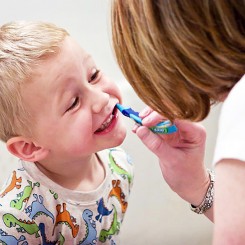
WATCHING YOUR CHILD’S first teeth come in is exciting. We understand that you want to keep those brand-new teeth as healthy as possible! But what tools will help you do an effective job?
You Can Use Toothpaste As Soon As Teeth Start To Appear
The American Academy of Pediatric Dentistry recommends that you start using toothpaste as soon as your child’s first tooth appears. Fluoridated toothpaste helps strengthen teeth and reduce the risk of caries. However, there are some specific guidelines for introducing fluoridated toothpaste into your child’s daily regime.
Before Age Three, Use A Rice-Sized Smear
Apply a very small smear to your child’s toothbrush, about the size of a grain of rice. Fluoridated toothpaste is most effective in low, frequent doses. Keep an eye on your child’s toothbrushing regime to ensure that toothpaste is being used properly.
After age three, start using a pea-sized dollop of toothpaste.
If Your Child Is Swallowing Toothpaste, Wait A While
Fluoridated toothpaste shouldn’t be swallowed in large amounts, but children under three don’t always have the coordination to effectively spit out their toothpaste.
So, if you’re concerned that your child is swallowing too much toothpaste, choose a fluoride-free option instead, or simply forgo toothpaste for a little while. While fluoridated toothpaste is a great tool, it’s not nearly as important as brushing itself. Your child can still get an effective scrubbing using just water!
A Great Toothpaste Can Make Toothbrushing Fun!
Here’s a little secret: for all the medical benefits that toothpaste labels boast, one of their most important functions is simply making brushing more enjoyable. So try out several kinds of toothpaste until you find one that your child is excited about.
Toothpaste flavor is really important to little ones’ sensitive taste buds. Most children don’t enjoy a bold minty taste like adults do. Bubblegum or fruit flavors are much more likely to be a hit.
We’re Here To Help!
Talk to us about your child’s brushing regime. We can let you know about the risks and benefits associated with each toothpaste option, let you know your child’s particular dental needs, and help you teach your child to brush effectively.
